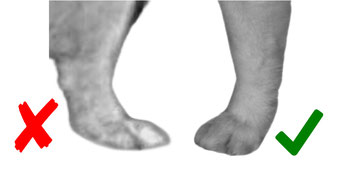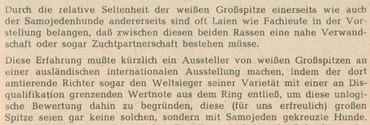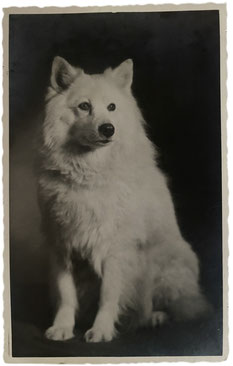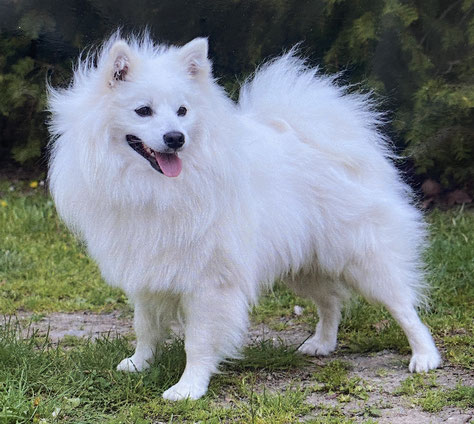White Giant Spitz or Samoyed?
About the differences between the two dog breeds
Because the white Giant Spitz, a variety of the German Spitz that is threatened with extinction, has unfortunately become so rare, laypeople often mistake them for Samoyed. Giant Spitz and Samoyed differ quite clearly from each other both in appearance and in character - at least if you know what to look out for. While Samoyeds are Nordic herding and sled dogs, our Giant Spitzes are basically the (!) original German farm dogs. The Samoyeds are related to our German Spitz, but their typical character traits have changed a lot over the centuries - they have gradually adapted more and more to their Nordic environment.
Who is the Samoyed?

The original Samoyeds were working dogs that were primarily used as sled and hunting dogs in their ancestral homeland, the far north. Where conditions do not allow for cars or horse-drawn carriages, the Samoyeds - sharing the hard struggle for existence of the local peoples - were bred for maximum performance. Varieties of the breed, such as the German Miniature Spitz, were therefore unable to develop in ares like that. People had to be able to rely on these dogs in this ice hell - where temperatures down to minus 50 degrees are not uncommon. In the tents made of animal skins and wood, the children took their Samoyeds to bed with them as substitutes for hot water bottles, the Samoyed women made blankets and clothing from the dog's combed wool, and the dogs were loyal companions for the men when herding the reindeer. When the tribe left a campsite, the Samoyed dogs pulled the sleds with the tents and other belongings over very long distances. They were robust, modest and acted independently.

So the previous tasks of the Samoyeds were:
- Hunting helper
- Sled dog
- Drive away vermin (rats, mice, etc.)
- Keep predators away and indicate them by barking (fox, wolf, bear)
- Looking after children (the dogs were taken to bed at night to keep warm)
- Herding reindeer and driving them from place to place
The German Spitz - like the Samoyeds - have also been indispensable to the common people throughout the centuries: be it as companions and guardians of belongings, or as playmates for children. And they were also rat catchers, cowherds and goose herders. In contrast to the Samoyeds, hunting Spitzes were absolutely undesirable because they were never allowed to leave the property entrusted to them. The independently acting, undemanding dogs had to be suspicious of every stranger and had to defend their house, farm and family against every foreign threat to the point of self-sacrifice.

The tasks of the German Spitz were:
- Guarding his master's household (including horses, chickens, etc.)
- Protecting his master's family
- Drive away or kill vermin
- Keep predators away and indicate them by barking
- Herding and driving cattle, etc
Under no circumstances were German leaders allowed to:
- leave the property that they had to guard
- poaching
- being friendly towards strangers

The detailed different areas of responsibility of white Spitz and Samoyeds clearly show the differences between the two breeds. In general, the German Spitz stands out from all other Spitz-like dogs - such as the Lapphund, the Elkhound and of course the Samoyed - in that they are the only breed from FCI Group 5 that are not allowed to have any hunting drive.
Back to the Samoyeds: In the second half of the 19th century, British and German researchers began to undertake their first expeditions to the North Pole, exploring the ice-cold north of Russia. The enduring dogs of the Samoyed peoples in Siberia proved to be extremely useful: the researchers used them as sled dogs where cars and horse-drawn vehicles failed.

With the advent of systematic breeding of dog breeds at the turn of the last century, the first Samoyeds finally came to England when British zoologist Ernest Kilbourne Scott imported the first white and cream dogs from Siberia in 1889. In their homeland, the Samoyeds still come in very different colors, from white to brown and black to two-tone or sable-colored animals. However, these colors are not recognized by the FCI.
Nowadays, there are basically two different types of Samoyed breeding: Samoyeds for work and Samoyeds for show. For each breed, the working breed is always focused on the origin of the breed. For the Samoyed, it is used as a sled dog. This in turn means that working dogs, for example, have a different coat structure and their physical characteristics also differ significantly from pure show dogs. The dogs, which still correspond to the original Samoyed type, visually resemble our white Giant Spitzes much more than the show dogs.
The differences between Samoyeds and white Giant Spitzes

The overall appearance of our German Spitz shows a square, short and stocky figure, while the Samoyed has the typical trotter structure of a utility or working dog. His back is longer, his tail rests less firmly on his back, and his hindquarters are much more angled. There are also significant differences in the shape of his head: the Samoyed's muzzle is longer, as are the ears and are set lower, the upper skull is flatter, and the eyes are significantly more slanted (more of a Mongolian type) than the Spitz's eyes.
The hair texture of the Samoyeds from the working line (i.e. the actual Samoyeds) is shaggier, slightly shorter and shows less pronounced the lush ruff and bushy tail of the German Spitz. The ruff of the Giant Spitz also stands off clearly from the rest of the fur, while the transition of the Samoyed is smooth. The Samoyed has more of kind of “full-body mane” from neck to tail.

The difference in the paws is also interesting: while we want to see very small paws - so-called "cat paws" - at the Spitz, the paws of the Samoyeds look more like big plates - also due to the very dense hair they have adapted to the climatic conditions in the north. This is a gift that nature gave the Samoyeds as protection against snow and ice.
With an ideal height at the withers of 57 ± 3 cm for males and 53 ± 3 cm for females, the Samoyeds are not only significantly larger than the German Spitz, but also significantly heavier: they weigh up to 30 kilograms (bitches at least 17 kilograms).

The best way to recognize the differences between white Spitz and Samoyeds is during their puppyhood, especially in Spitz-Samoyed mixes. Breed-specific characteristics that grow later are usually still quite visible in the puppy.
Samoyed puppies can be easily recognized by the fact that their eyes are not only narrower than the eyes of young Spitz, but also that they tilt downwards to the sides and are framed by very strong, white eyelashes on the upper eyelid. The young Spitz's eyes, on the other hand, are neither narrow nor are their eyelashes that noticeable. Young Samoyeds also have puffy-looking "fur cheeks", whereas young Spitz don't.

And now take a closer look at the adjacent picture 4 again! The puppy on the far left (Samoyed) is very different from the two German Spitz puppies that can be seen on the right in the picture. Eyelashes, tilted eyes, fluffy fur cheeks. Don't have the Spitz puppies. The puppy in the middle was officially sold as a Giant Spitz, but anyone who is able to see will see: bright eyelashes, tilted eyes and fluffy fur cheeks. Wonderful cuckoo egg. 😬
Because Samoyeds were originally used as hunting and sled dogs, they tend to be relatively active. The former working dogs need a lot of attention and, with their engaging nature, make many friends among people in a short time. However, today's Samoyeds from Europe or the USA are no longer the work-loving all-round dogs that they were in their Siberian homeland: they signal visitors by barking, but can be easily bribed with friendly words or treats. They are therefore absolutely not suitable as guard dogs - in complete contrast to our German Spitzes. If they have been bred and trained correctly, these are excellent guardians.
Secret crossbreeding?

According to many rumors, from the late 1980s onwards, Samoyeds were secretly crossed into the population of the white Giant Spitzes. But even in the first decades after the Second World War, old photos show astonishingly large and very strong, white Giant Spitzes. But he who is without sin, let him cast the first stone: due to the dangerously small population of the white Giant Spitz since the War until today, the breeders basically had no other option than to become "creative", so to speak. No breeding without dogs! They certainly benefited from the fact that the Samoyeds in Germany in the 1950s were looked after by the “German Spitz Club” for several years. But of course what shouldn't be can't happen, there were reports in the German Spitz Club magazine "Der Deutsche Spitz" like this one:

Whether foreign breeds were actually crossed into the German Spitz can neither be clearly proven, nor does it play a role today. As long as the breeders' main focus is on preserving the actual Giant Spitz - and not just on appearance - such "experiments" born out of necessity are to be neglected.
Incidentally, there are also rumors of secret cross-breeding among the Samoyeds: with the closure of the trade route between the West and Siberia after the Second World War, the opportunity for breeders to obtain fresh blood from the Samoyeds' northern homeland also closed. This presented a very big challenge to the preservation of the breed. Finally, several reports show that Chow-Chows were crossed into the Samoyed population between 1930 and 1950, and crosses with Wolfspitzes probably also took place. Necessity is the mother of invention.... 😉
What is striking is that the Samoyed breed, which was once perfected in England, hardly a century later in the same country basically has almost no dogs of the original type left. Funny. That seems somehow familiar to me...🤔
Related articles:
About the difference in building: Spitz or Eskie?
About the breed standard: Illustrated breed standard of the German Spitz
About the large Spitz: The Giant Spitz
Image sources:
(1) https://pin.it/7hUFFsa
(2) © Birgit Kaiser Photography (www.tierportraits-b-kaiser-de.webnode.com)
(3) From "Der Deutsche Spitz", no. 16, p. 9
(4) https://pin.it/78zfTp9
(5) https://pin.it/Q9dbqCA
04.10.2023






